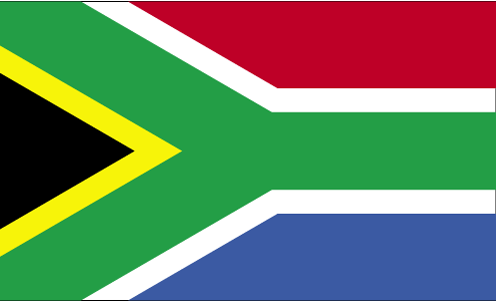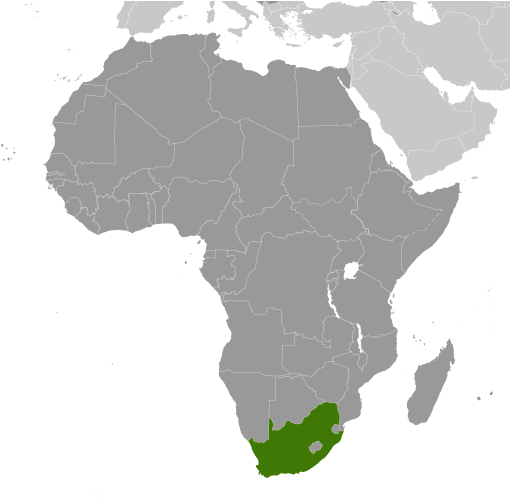|
Country name:
|

|
|
conventional long form: Republic of South Africa
conventional short form:
South Africa
former:
Union of South Africa
abbreviation:
RSA
|
|
|
Government type:
|

|
|
republic
|
|
|
Capital:
|

|
|
name: Pretoria (administrative capital)
geographic coordinates:
25 42 S, 28 13 E
time difference:
UTC+2 (7 hours ahead of Washington, DC during Standard Time)
note:
Cape Town (legislative capital); Bloemfontein (judicial capital)
|
|
|
Administrative divisions:
|

|
|
9 provinces; Eastern Cape, Free State, Gauteng, KwaZulu-Natal, Limpopo, Mpumalanga, Northern Cape, North-West, Western Cape
|
|
|
Independence:
|

|
|
31 May 1910 (Union of South Africa formed from four British colonies: Cape Colony, Natal, Transvaal, and Orange Free State); 31 May 1961 (republic declared); 27 April 1994 (majority rule)
|
|
|
National holiday:
|

|
|
Freedom Day, 27 April (1994)
|
|
|
Constitution:
|

|
|
10 December 1996; note - certified by the Constitutional Court 4 December 1996; was signed by then President MANDELA 10 December 1996; and entered into effect 4 February 1997
|
|
|
Legal system:
|

|
|
mixed legal system of Roman-Dutch civil law, English common law, and customary law
|
|
|
International law organization participation:
|

|
|
has not submitted an ICJ jurisdiction declaration; accepts ICCt jurisdiction
|
|
|
Suffrage:
|

|
|
18 years of age; universal
|
|
|
Executive branch:
|

|
|
chief of state: President Jacob ZUMA (since 9 May 2009); Deputy President Kgalema MOTLANTHE (since 11 May 2009); note - the president is both the chief of state and head of government
head of government:
President Jacob ZUMA (since 9 May 2009); Deputy President Kgalema MOTLANTHE (since 11 May 2009)
cabinet:
Cabinet appointed by the president
(For more information visit the World Leaders website  ) )
elections:
president elected by the National Assembly for a five-year term (eligible for a second term); election last held on 6 May 2009 (next to be held in 2014)
election results:
Jacob ZUMA elected president; National Assembly vote - Jacob ZUMA 277, Mvume DANDALA 47, other 76
|
|
|
Legislative branch:
|

|
|
bicameral Parliament consisting of the National Council of Provinces (90 seats; 10 members elected by each of the nine provincial legislatures for five-year terms; has special powers to protect regional interests, including the safeguarding of cultural and linguistic traditions among ethnic minorities) and the National Assembly (400 seats; members elected by popular vote under a system of proportional representation to serve five-year terms)
elections:
National Assembly and National Council of Provinces - last held on 22 April 2009 (next to be held in April 2014)
election results:
National Council of Provinces - percent of vote by party - NA; seats by party - NA; National Assembly - percent of vote by party - ANC 65.9%, DA 16.7%, COPE 7.4%, IFP 4.6%, other 5.4%; seats by party - ANC 264, DA 67, COPE 30, IFP 18, other 21
|
|
|
Judicial branch:
|

|
|
Constitutional Court; Supreme Court of Appeals; High Courts; Magistrate Courts
|
|
|
Political parties and leaders:
|

|
|
African Christian Democratic Party or ACDP [Kenneth MESHOE]; African National Congress or ANC [Jacob ZUMA]; Congress of the People or COPE [Mosiuoa LEKOTA]; Democratic Alliance or DA [Helen ZILLE]; Freedom Front Plus or FF+ [Pieter MULDER]; Inkatha Freedom Party or IFP [Mangosuthu BUTHELEZI]; Pan-Africanist Congress or PAC [Motsoko PHEKO]; United Christian Democratic Party or UCDP [Lucas MANGOPE]; United Democratic Movement or UDM [Bantu HOLOMISA]
|
|
|
Political pressure groups and leaders:
|

|
|
Congress of South African Trade Unions or COSATU [Zwelinzima VAVI, general secretary]; South African Communist Party or SACP [Blade NZIMANDE, general secretary]; South African National Civics Organization or SANCO [Mlungisi HLONGWANE, national president]
note:
note - COSATU and SACP are in a formal alliance with the ANC
|
|
|
International organization participation:
|

|
|
ACP, AfDB, AU, BIS, BRICS, C, CD, FAO, FATF, G-20, G-24, G-77, IAEA, IBRD, ICAO, ICC (national committees), ICRM, IDA, IFAD, IFC, IFRCS, IHO, ILO, IMF, IMO, IMSO, Interpol, IOC, IOM, IPU, ISO, ITSO, ITU, ITUC (NGOs), MIGA, MONUSCO, NAM, NSG, OECD (Enhanced Engagement, OPCW, Paris Club (associate), PCA, SACU, SADC, UN, UNAMID, UNCTAD, UNESCO, UNHCR, UNIDO, UNITAR, UNSC (temporary), UNWTO, UPU, WCO, WFTU (NGOs), WHO, WIPO, WMO, WTO, ZC
|
|
|
Diplomatic representation in the US:
|

|
|
chief of mission: Ambassador Ebrahim RASOOL
chancery:
3051 Massachusetts Avenue NW, Washington, DC 20008
telephone:
[1] (202) 232-4400
FAX:
[1] (202) 265-1607
consulate(s) general:
Chicago, Los Angeles, New York
|
|
|
Diplomatic representation from the US:
|

|
|
chief of mission: Ambassador Donald H. GIPS
embassy:
877 Pretorius Street, Pretoria
mailing address:
P. O. Box 9536, Pretoria 0001
telephone:
[27] (12) 431-4000
FAX:
[27] (12) 342-2299
consulate(s) general:
Cape Town, Durban, Johannesburg
|
|
|
Flag description:
|

|
|
two equal width horizontal bands of red (top) and blue separated by a central green band that splits into a horizontal Y, the arms of which end at the corners of the hoist side; the Y embraces a black isosceles triangle from which the arms are separated by narrow yellow bands; the red and blue bands are separated from the green band and its arms by narrow white stripes; the flag colors do not have any official symbolism, but the Y stands for the "convergence of diverse elements within South African society, taking the road ahead in unity"; black, yellow, and green are found on the flag of the African National Congress, while red, white, and blue are the colors in the flags of the Netherlands and the UK, whose settlers ruled South Africa during the colonial era
note:
the South African flag is one of only two national flags to display six colors as part of its primary design, the other is South Sudan's
|
|
|
National symbol(s):
|

|
|
springbok antelope
|
|
|
National anthem:
|

|
|
name: "National Anthem of South Africa"
lyrics/music:
Enoch SONTONGA and Cornelius Jacob LANGENHOVEN/Enoch SONTONGA and Marthinus LOURENS de Villiers
note:
adopted 1994; the anthem is a combination of "N'kosi Sikelel' iAfrica" (God Bless Africa) and "Die Stem van Suid Afrika" (The Call of South Africa), which were respectively the anthems of the non-white and white communities under apartheid; the official lyrics contain a mixture of Xhosa, Zulu, Sesotho, Afrikaans, and English; the music incorporates the melody used in the Tanzanian and Zambian anthems
|
|
|
|
|





 )
)



